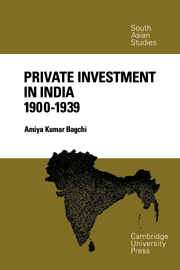Book contents
- Frontmatter
- Contents
- List of tables
- Preface
- Abbreviations
- PART I GENERAL – THEORETICAL FRAMEWORK
- 1 Introduction
- 2 The economic policy of the Government of India
- 3 The record of aggregate private industrial investment in India, 1900–1939
- 4 Land and the supply of raw materials
- 5 The supply of unskilled labour
- 6 The supply of capital and entrepreneurship
- PART II STUDIES OF MAJOR INDUSTRIES
- Bibliography
- Index
3 - The record of aggregate private industrial investment in India, 1900–1939
from PART I - GENERAL – THEORETICAL FRAMEWORK
Published online by Cambridge University Press: 06 January 2010
- Frontmatter
- Contents
- List of tables
- Preface
- Abbreviations
- PART I GENERAL – THEORETICAL FRAMEWORK
- 1 Introduction
- 2 The economic policy of the Government of India
- 3 The record of aggregate private industrial investment in India, 1900–1939
- 4 Land and the supply of raw materials
- 5 The supply of unskilled labour
- 6 The supply of capital and entrepreneurship
- PART II STUDIES OF MAJOR INDUSTRIES
- Bibliography
- Index
Summary
The aim of the present chapter is to trace the broad history of private investment in manufacturing industries in India and relate it to broad movements of national product and external factors. Investment in mining and plantation industries is entirely excluded. Furthermore, the discussion is centred on movements of investment in large-scale rather than in small-scale industries. But no rigid distinction is drawn between large-scale and small-scale industries because the data do not allow such discrimination in every case.
In the beginning of the period only two large-scale manufacturing industries, viz., cotton and jute mills, employed more than 20,000 people. At the end of the period, several others, notably iron and steel, sugar and cement had been added to the list. But up to the end of the twenties the cotton and jute mills dominated the industrial field as indeed they did, although less completely, even in 1950. But at least public attention had been shifted to other fields by the latter date.
Even when data regarding manufacturing concerns are systematically collected, the measurement of investment is a tricky affair. The problems arise out of changes in prices of the different constituents of the capital stocks of companies, which determine the correct level of depreciation, changes in the price levels of commodities in general and changes in rates of interest. For India during the period under review, the problems are even more difficult.
- Type
- Chapter
- Information
- Private Investment in India 1900–1939 , pp. 68 - 92Publisher: Cambridge University PressPrint publication year: 1972



